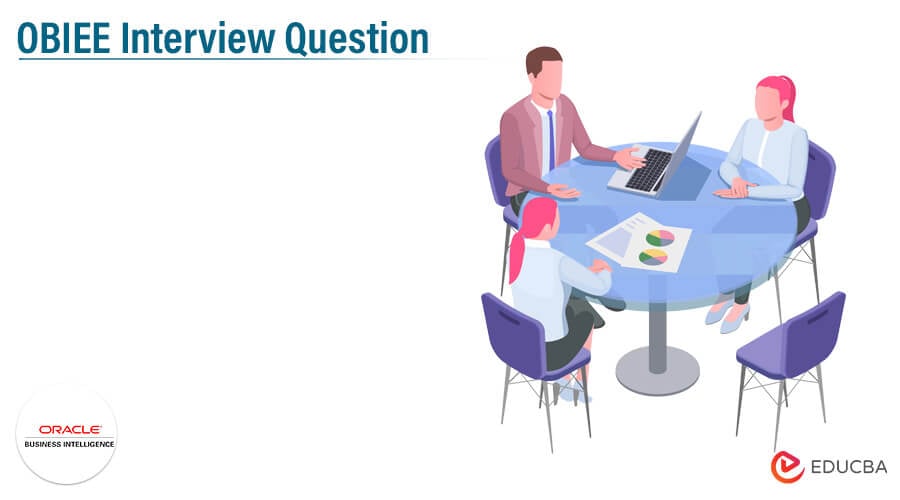Updated June 15, 2023
Introduction to OBIEE Interview Questions and Answers
Oracle Business Intelligence Enterprise Edition (OBIEE) is a Business Intelligence product developed by Oracle Corporation. This is also called OBI EE Plus. This tool is part of Business Intelligence tools from Oracle. This tool is mainly written in Java and C++ programming languages that support multiple platforms. This is business analytics software and is also licensed proprietary software.
If you are looking for a job related to OBIEE, you must prepare for the 2023 OBIEE Interview Questions. Though every OBIEE interview is different and the job scope is also different, we can help you with the top OBIEE Interview Questions and Answers, which will help you take the leap and succeed in your interview. Keeping this in mind, we have designed the most common OBIEE Interview Questions and Answers to help you get success in your interview.
Part 1 – OBIEE Interview Questions (Basic)
This first part covers basic Interview Questions and answers.
1. What is Oracle Business Intelligence Enterprise Edition (OBIEE)?
Answer:
Oracle Business Intelligence Enterprise Edition (OBIEE) is a platform for developing business intelligence and analytics applications that deliver the full range of capabilities such as dashboards, reporting, analytics, alerts and notifications, customized queries, and financial reporting business processes, integrated systems management. OBIEE is built on a modern technological foundation that supports complex deployments and more workloads.
Oracle Business Intelligence Enterprise Edition (OBIEE) contains an interactive dashboard solution that provides fully interactive reporting tools. OBIEE also includes integration with Microsoft Excel. Oracle Business Intelligence Server is the key component and foundation of Oracle Business Intelligence Enterprise Edition (OBIEE). OBIEE provides a parallel query in its execution engines, memory management, high-throughput data, and connectivity adapters which allows highly efficient data sources and minimizes the data retrieval time.
2. What are the main features of OBIEE?
Answer:
The OBIEE features include Interactive Dashboards, Enterprise Reporting, Self Service Report Creation, Microsoft Office Integration, Proactive detection and alerts, Actionable Intelligence, and Map Visualization. In OBIEE, a user can create interactive dashboards. OBIEE provides enterprise reporting that is used to customize and generate different forms of templates. OBIEE also contains a powerful real-time alerting engine that provides notifications and alerts based on business events. This is used for messaging events or application monitoring systems that will be highly utilized for application alerts.
The advantages of OBIEE are:
- Visualization.
- Report creation from scratch.
- User-friendly, flash report.
- Report template.
- Integration with primary data sources.
- Online analytical processing (OLAP).
- Analysis with presentation and transaction processing.
The databases that can be integrated with Oracle Business Intelligence Enterprise Edition (OBIEE) are IBM DB2, Microsoft SQL Server, Teradata, Microsoft Analysis Services, and SAP Business Information Warehouse (BW). There are several operational benefits of using OBIEE.
3. What is an interactive dashboard in OBIEE?
Answer:
Oracle Business Intelligence Enterprise Edition (OBIEE) has an interactive dashboard for presenting different data formats by providing several visualization graphics structures with other forms. Users can benefit from ad-hoc query analysis by using a dashboard feature. OBIEE dashboard comes under the application’s presentation layer that provides the presentation to user views. Business Intelligence publisher provides BI dashboards.
Interactive dashboards provide access to the needed, actionable, and dynamically customized information based on the individual’s role, identity, and requirement. Oracle Business Intelligence Enterprise Edition (OBIEE) and Oracle Business Intelligence interactive dashboards environment provide different features where the end users can work with live reports, charts, tables, pivot tables, graphics, prompts, and tickers incomplete web architectures. OBIEE aggregates different content formats from sources like the Internet, file hosting servers, and document or content management repositories. The access management system in OBIEE provides information interactively based on the individual user’s role and identity.
Part 2 – OBIEE Interview Questions (Advanced)
This first part covers advanced Interview Questions and answers.
1. What are the different OBIEE server components?
Answer:
The different server components of OBIEE are Oracle BI (OBIEE) Server, Application Server, Oracle Presentation Server, Cluster Controller, and Scheduler. Oracle BI Server is the main component and base of the Oracle Business Intelligence Enterprise Edition (OBIEE), which establishes communication among different system members. An OBIEE application server provides the mechanism to work with client components. OBIEE suite contains an application server as an inbuilt feature provided by Oracle.
OBIEE components include server and client components, different client-based parts are available such as Interactive Dashboards, Oracle Delivers, BI Publisher, BI Presentation Service Administrator, Answers, Disconnected Analytics, and MS Office Plugin. It also contains non-web-based clients such as OBIEE administration and OBIEE clients. The client used to connect to the database system and execute the SQL query commands. The presentation layer is a single-page application that provides dashboards and user interfaces for the users to interact with the server components as required.
2. What is the Oracle BIEE repository?
Answer:
Oracle Business Intelligence Enterprise Edition (OBIEE) repository contains the important metadata information of the Business Intelligence Server, which can be managed through admin console management. The different types of information stored in the application environment are Data Modelling, Aggregate Navigation, Caching, Security, Connectivity Information, and SQL Information. Using the configuration, a repository can also be modified. OBIEE has two different versions, called 10g and 11g, as its software package versions. Before making life, always a repository should be created offline initially. In OBIEE, different metadata types and data source views will be available to select while creating a repository.
Recommended Article
We hope that this EDUCBA information on “OBIEE Interview Questions” was beneficial to you. You can view EDUCBA’s recommended articles for more information.



